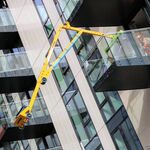MisterF
Senior Member
True, there's a lot of grey areas between different terms. In most definitions of a metro, the common themes are a frequent electrified train running an exclusive, grade separated right of way with no interference from cars or pedestrians. Even that is a bit restrictive because nobody insists that the Chicago El isn't a true metro. There's nothing that eliminates something like REM or the Skytrain because they use a slightly different type of vehicle compared to most systems that we traditionally call metros. Despite nfitz's insistence to the contrary, they are both absolutely metro systems. I'd consider Ottawa's Confederation Line a metro too; it meets all the requirements. And Edmonton's LRT runs just like a metro even though it has at grade crossings.The thing about these debates is that it turns out there's just varying shades of grey, nothing is black and white. Is Chicago's El a metro? It's heavy rail, frequent, yet not entirely grade seperated. How about Vienna's U6? It's entirely grade seperated, but uses low floor light rail vehicles. If it's a metro, then what's Ottawa's confederation line which is virtually identical in terms of rolling stock, grade seperation and capacity, but it's called LRT. The Canada line in Vancouver uses the same rolling stock as several asian metro systems, and the vehicles are as wide as a TR train, but because it's only two cars long is it a metro? If it's not, then what's Cincinnati's red line which is also only two cars long, yet generally considered a "real" metro. What about the shuttle lines on the NYC subway which are also 2 cars?
It's all just becomes very fuzzy, so arguing over the terminology goes nowhere. So instead a better comparison is how does the Montreal Metro + REM compare against all the planned lines of the TTC, which includes lines 5,6,7 and 8, even though all those are "LRT". I'd exclude Go RER since it's more regional than urban focused, but even that point is debatable.
That's why I don't put Toronto's lines 5-8 on the same level as any of the systems listed above. All of our new lines lines will run on the street and stop at red lights (except the parts that are in tunnels). That's a fundamental difference in how they operate compared to anything called a metro. Of course there's no 100% authoritative opinion on this, but IMO if it stops at red lights, it isn't rapid transit. RER will play that role more than any Transit City line except maybe Eglinton.
No offence, but this is what I meant in my other post about Torontonians making excuses. Wide trains don't change the fact that Montreal and Vancouver have both built much more rapid transit than Toronto in the last several decades despite them being smaller, less wealthy, and having less demand for transit. Wide trains do nothing to expand coverage of the city, which is sorely lacking in Toronto compared to the other two cities.The Montreal Metro cars are 2.51 m (8 ft 2 7⁄8 in) in width.
The Toronto legacy streetcars (CLRV, ALRV, Flexity Outlook) are 2.54 m (8 ft 4 in) in width.
The Eglinton Crosstown LRT Flexity Freedom cars are 2.65 m (8 ft 8 in) in width.
The Toronto Subway cars are 3.14 m (10 ft 3 5⁄8 in) in width.
Again, I'm not sure why you're inventing this division of the part of the system that's off the island. Whether it's on the island or not, whether it's a project led by the city of Montreal or not, it's still a metro and part of the city's system.Perhaps you are not aware that those 3 stations were not in Montreal, nor built by the city? That outside-of-Montreal extension wasn't even on the list of proposed lines in 1980s and early 1990s, that was prominently touted (the Orange line extension to Bois-Franc, the Blue line extension to Lasalle and Montreal-Nord (later changed to Anjou), the white line down Pie-IX to Montreal Nord, and the various LRT proposals.










